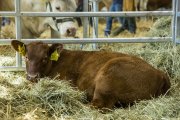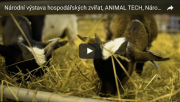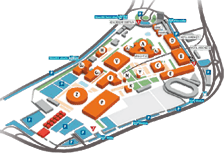Interest shown in the separate exhibition of livestock was a pleasure for us says David Lipovský of the Bohemian-Moravian Breeders Association
 The
National Show of Livestock is a real breeders‘ feast. This is testified by the
fact that living specimens were carried to Brno by 36 vehicles, some of which
had to come several times. The organizers addressed virtually all carriers
licensed to transport livestock. "This is the largest concentration of
farm animals exhibited in one place in the Czech Republic," confirms David
Lipovský, head of the breeding department of Czech-Moravian Breeders
Association, on behalf of the organizers.
The
National Show of Livestock is a real breeders‘ feast. This is testified by the
fact that living specimens were carried to Brno by 36 vehicles, some of which
had to come several times. The organizers addressed virtually all carriers
licensed to transport livestock. "This is the largest concentration of
farm animals exhibited in one place in the Czech Republic," confirms David
Lipovský, head of the breeding department of Czech-Moravian Breeders
Association, on behalf of the organizers.
What do figures say about the show?
To recapitulate, there are 360 representatives
of meat breeds of cattle on the display, 160 dairy cows, 60 pigs, over 200
sheep and goats including lambs and kids, 100 horses and 30 western horses.
The Czech-Moravian
Breeders Association took to organize the entire livestock show for the first
time. How complicated was that?
It is very demanding to gather and logistically
ensure the transport of the animals, provide barriers, carers, feed, collection
of milk and dung, etc. The organization of an exhibition of this size would of
course not be possible without financial support from the Ministry of
Agriculture and without the background provided to us by the Brno Exhibition Centre.
Of course, BVV give us time limits. In this context, I would like to mention
one point: we have installed a special floor covering under most of the displayed
cattle, which allows us to quickly build up the display and then clean it up in order to make the hall
ready for the next event.
How does this year’s show differ from previous
years?
In previous years, the show of livestock was
part of the Techagro fair, where a large part of the area was occupied by
equipment, or in years when Techagro did not take place, it ran concurrently
with a pet show. This year is the first time when the show of livestock runs
independently, only with its accompanying programmes. I am pleasantly surprised
by the number of visitors that the first individual year has come up to.
Perhaps we have started a good tradition by that.
The exhibition has in
its title the word “national“, but judging from the attendance of experts, it
already has an international nature. For example, international jurors came
from the Netherlands, France or the USA, foreign journalists, organizers also
invited a Dutch professional photographer specializing in cattle photography,
and many foreign delegations interested in collaborating in the field of
genetic material were introduced during the opening ceremony. What do you see
the main benefit in?
In the short run the result cannot be seen
immediately, but there are breeders meeting here and comparing their breeding
results among them. I would also like to emphasize that the ministry has
managed to bring together over 100 participants of foreign missions from
different parts of the world who were introduced to our genetics. We are heard
about again. From the interest demonstrated, I estimate that future business
relationships may be shaping with countries that are not yet interesting to us
today, but might become interesting in the future. Examples are the countries
of the former Soviet Union, in which many companies already have contacts nowadays
and in which some animals are exported, even if they are limited by the
veterinary conditions or the purchasing power of the countries concerned. But
the potential of these countries is enormous, and surely agriculture will gain
more significance there. It would be good if the Czech Republic were to ride
this wave of increasing interest.
Various associations of breeders, whether Czech
beef cattle, Holstein cattle, meat cattle, etc., are presented at the
exhibition. Is it possible to say briefly how the various groups are doing?
That's cannot be said so simply. Last year, for
example, was very difficult for dairy cow breeders, because milk was on a
downward sinusoidal wave of purchase prices. Now it is a bit rising, but every
year is problematic for someone else – for some it’s more profitable, for
others less effective and this is changing constantly. I think farmers have
become accustomed to having fat and slim years, and they must learn to count on
it in their economic plans.
In your opinion, what is the outlook for the
next yearly edition of the show?
When
I see the interest of visitors this year, I think the current exhibitors will
come again and those who have come just to take a look this year will seriously
consider their participation.
NVHZ
For Exhibitors
For Media
Partners
![]()
Concurrently with
You might be interested in
Exhibitors 2021







